 Large boat intercepted off Tobruk, Libya, on 15 December. Source: @brirmijihed
Large boat intercepted off Tobruk, Libya, on 15 December. Source: @brirmijihed
Introduction
In 2022, the Alarm Phone was alerted to 673 boats in distress in the central Mediterranean region. In view of 27 distress cases in 2018, 101 in 2019, 173 in 2020, and 407 in 2021, 2022 was by far the busiest year the Alarm Phone has experienced in this region. This increase in alerts to boats in distress reflects an overall increase in crossings as well as a growing awareness of the Alarm Phone among communities ‘on the move’.
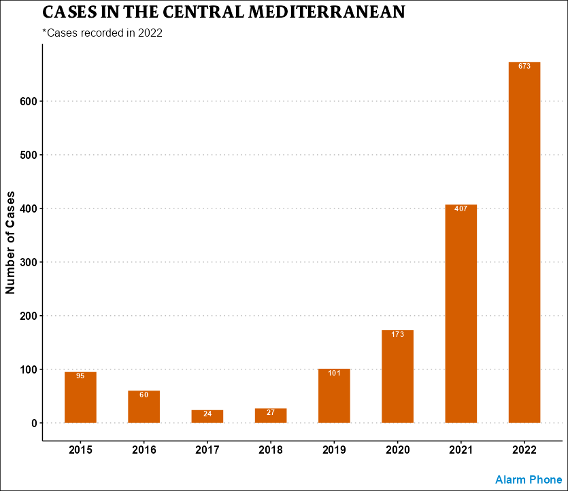
About 105,000 people have arrived through the central Mediterranean route, a considerable increase to the 67,500 people who arrived in 2021, the 34,000 in 2020, and 11,500 in 2019. This increase highlights that despite European efforts to build up, finance, and equip the so-called Libyan coastguard over recent years, and despite intensifying cooperation between European and Tunisian authorities, people continue to succeed in escaping across the sea.
The vast majority of people arriving in Italy arrived autonomously or were rescued only a few nautical miles off Italian coasts. People on the move have adapted to European forms of non-assistance where they cannot expect to be rescued by European authorities over considerable distances, especially in the Maltese Search and Rescue (SAR) zone. According to the UNHCR, only 430 people were rescued to Malta, showing once more the reluctance of the Armed Forces of Malta to engage in rescue operations.
Despite the high number of arrivals, tens of thousands of people were not able to reach Europe, being abducted at sea and returned to the places they tried to escape from. Tunisian coastguards have repeatedly engaged in dangerous interception operations, some of which have ended deadly. According to the Forum Tunisien pour les Droits Économiques et Sociaux (FTDES), about 29,000 people were returned to Tunisia until the end of October 2022. The IOM estimates that about 24,700 people were returned to Libya from the sea.
The withdrawal of European rescue assets and the systematic non-assistance of boats in distress at sea have cost lives at sea. The IOM estimates that 1,377 people have died or disappeared in the central Mediterranean in 2022 – of course an undercount as many deaths and disappearances are never accounted for. Family members regularly contact Alarm Phone in their desperate search for their loved ones and many, including families in Zarzis/Tunisia, have taken to the streets to protest EU border violence and demand answers from the European and Tunisian authorities about their missing children. From 3 to 5 September, we joined the CommemorAction in Zarzis, as a meeting space for relatives, friends and community members of people who went missing or lost their lives at the EU borders, as well as for civil society organizations willing to support them and amplify their voices.
As in previous years, the civil fleet has sought to fill the deadly rescue gap created by Europe but was regularly hampered by European authorities. Especially since the election of the fascist Meloni government in Italy, the civil fleet has faced numerous attacks and restrictions. Shortly after coming to power, the government tried to prevent the NGO vessels Ocean Viking, Geo Barents, Rise Above, and Humanity1 from disembarking rescued people at Italian harbors. After failing to implement a new strategy whereby only those considered ‘vulnerable’ would be allowed to disembark, the government tried a different approach, issuing a decree in December 2022, passed in January 2023. The decree includes a provision that would force NGO rescuers to move immediately to a port after a single rescue operation, thereby considerably cutting down their operational time and wasting their rescue capacity. Moreover, already in December, several rescue NGOs were instructed by the Italian authorities to disembark the rescued in northern Italian harbors, thus extending their absence from the deadliest areas in the central Mediterranean Sea.
Despite these attacks on the civil fleet, the Alarm Phone has successfully cooperated with NGO rescuers on numerous occasions, leading to the rescue of over 100 boats in distress over the last year. Together with the civil aerial assets, the Civil Maritime Rescue Coordination Centre, and the civil fleet, we have documented and frequently prevented European forms of non-assistance and pushbacks. Also in 2023, we will continue to enact our solidarity with people on the move and fight the EU border regime that causes thousands of deaths every year.
In this analysis, we reflect on developments that have occurred over the last six months of 2022:
The first section highlights how the new Italian far-right government tries to obstruct civil society’s presence at sea.
The second section examines the increasingly dangerous Tunisian route and the ongoing struggle for truth in Zarzis.
This is followed by the third section, which discusses the attacks by the Tunisian Coast Guards on escaping boats, which have become frequent. It also provides a testimony of someone who survived such a vicious attack.
In the fourth section, we reflect on the rise in crossing from eastern Libya, especially Tobruk, where a number of large boats have recently departed.
Section five highlights the torturous conditions on migrant boats – forms of dehydration, a lack of food, sickness and injuries – and the denial by EU authorities of basic care.
This is followed by section six, in which we discuss the role and usefulness of merchant vessels in Search and Rescue (SAR) operations.
Finally, we offer a detailed chronology of events in the central Mediterranean Sea. Documenting these developments is important: no other actor compiles such a detailed account – we have to create our own archive of migrant struggles and acts of solidarity, as well as forms of border violence at sea.
1 From selective disembarkation to distant Ports of Safety: How the new far-right government of Italy tries to obstruct civil society presence at sea
Following the election of the new far-right government, Italy’s SAR policy at sea underwent considerable changes. First of all, and despite many studies showing that SAR NGOs cannot be considered a ‘pull factor’ for departures from North Africa, the government took up this narrative and made it the focus of its most recent ‘war on NGOs’. In the weeks immediately after taking office, it attempted to restrict the access of SAR NGOs to territorial waters by implementing a policy of ‘selective landings’.
At the end of October, the ships Humanity1 (Sos Humanity), Geo Barents (MSF), Rise Above (Mission Lifeline) and Ocean Viking (SOS Mediterranee) were in the central Mediterranean, having rescued around 1,000 people. On that occasion, newly appointed Minister Piantedosi sent notes to the German and Norwegian embassies, claiming that the ships flying their flag (Humanity1 and Geo Barents) were carrying out activities that were not in line with the spirit of EU border control regulations.
This was followed by two similar decrees, called ‘the illegal decrees’, aimed at limiting the period that NGO ships could remain in Italian territorial waters to the time it would take to disembark people in a critical medical condition. Those deemed not to be in such condition were supposed to remain on board and leave the port again. The captains, however, refused to carry out this unlawful order, which would have amounted to collective rejection. The people on board began hunger strikes and protests, and some threw themselves overboard.
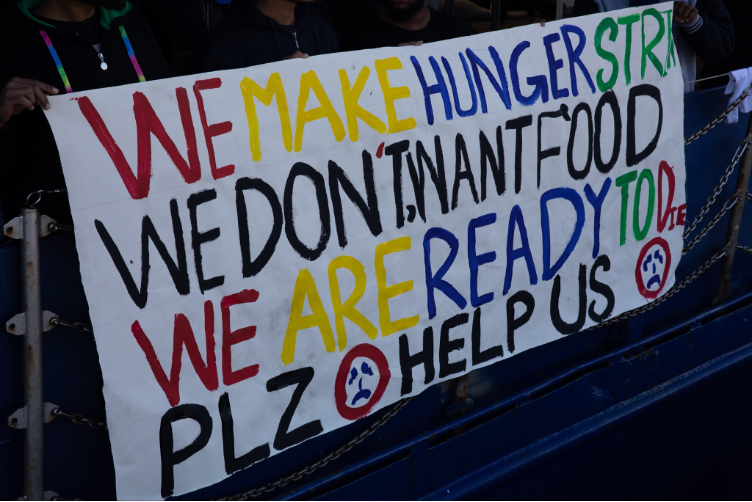 Protests onboard Humanity I, against the selective disembarkation. Source: Max Cavallari – Sos Humanity
Protests onboard Humanity I, against the selective disembarkation. Source: Max Cavallari – Sos Humanity
The NGOs’ lawyers filed an appeal with the Lazio Regional Administrative Court, claiming the illegitimacy of the decrees issued by the government. Associations of doctors and psychologists expressed their dissent, with letters contesting the subjugation of health assessment criteria to border surveillance purposes. Doctors from the local health authorities then came on board and – certifying that the stand-off was a risk factor for the mental health of all those left on board – managed to facilitate their disembarkation.
During these days, a different treatment was reserved for the vessel Rise Above, which was assigned the port in Reggio Calabria where all survivors disembarked. Finally, the Ocean Viking, after more than 30 unanswered POS requests, headed for Marseille, and subsequently disembarked people in Toulon. There, the survivors were detained in a transit area, and many of them threatened with repatriation. Finally, two people were deported, as the time limit for the others in the ‘waiting area’ was over before judges could decide, the others could ‘enter’ France.
After the failure of the ‘selective disembarkation’ strategy, the Italian government did not give up in its struggle against SAR NGOs, and issued a new decree – theoretically aimed at further regulating their presence at sea, but with the real goal of obstructing lifesaving rescue efforts at sea. As civil organizations engaged in SAR activities highlighted, the decree is in violation with the Italian Constitution and the international legal framework on SAR and will cause more deaths, by increasing the rescue gap created by the progressive delegation of SAR responsibility to unsafe countries, such as Libya and Tunisia. The decree includes some worrying provisions, among them the obligation for NGOs to proceed towards an – increasingly distant – Port of Safety (POS) assigned immediately after each rescue (such as Ravenna, Ancona, and so on).
Instructing SAR NGOs to proceed immediately to a port while boats are in distress at sea contradicts the captain’s obligation to render immediate assistance to people in distress, as enshrined in the UNCLOS. Still,this is what was already done in the night between 7 and 8 January. Although Geo Barens showed its availability to rescue a boat with 45 people onboard in international waters, they were required to proceed to the assigned POS, leaving the boat to be intercepted by the so-called Libyan coastguard, and people sent back to detention, torture, extorsion, and other forms of structural violence against people on the move.
This new set of rules is just the last one of the many wide-ranging attempts by Italian governments since 2017 to prevent NGO presence at sea.
2 The dangerous Tunisian route and the ongoing struggle for truth in Zarzis
Since 2020, the number of shipwrecks and disappearances of boats close to the Tunisian coast have been increasing. According to figures from the FTDES (Tunisian Forum for Economic and Social Rights), between the beginning of the year and the end of November 2022, more than 575 people have died when trying to reach Italy. To this figure, one must also add the “invisible” shipwrecks, those countless boats which disappear without leaving any traces.
For over four months, the south-eastern Tunisian town of Zarzis has been mobilizing to seek truth and justice regarding the disappearance of 17 people who had left the shores of the town on 21 September 2022 in order to reach Europe. A fiber-glass motorboat of approximately 6 meters, carrying the people, had left from Zarzis at around 8pm on the evening of 21 September 2022.
Given the type of boat, its weight, speed (estimated at around 14 km/h), and the weather conditions, the maximum estimated time for their crossing to Lampedusa was 30 hours: it was therefore expected that the boat would reach Italy at the latest during the night of the 22nd. Two days after their departure, in the absence of news, the families alerted the National Maritime Guard in Zarzis, urging them to search for their loved ones at sea. In addition, they started spreading their concern between networks in Tunisia, Italy, and beyond. Alarm Phone was contacted as well by almost 40 people, including relatives, friends, civil society members.
 Road block in the Souihel neighbourhood, where most of the missing people from the September 21 shipwreck came from. Source: Felice Rosa
Road block in the Souihel neighbourhood, where most of the missing people from the September 21 shipwreck came from. Source: Felice Rosa
Faced with the passivity of the authorities, the Zarzis Fishermen’s Association launched autonomous search operations on 26 September. These operations, which led to the discovery of two bodies, were interrupted that same day due to rumors that the 17 people had been brought to Libya. This information was shared by the association of retired military personnel and was then confirmed by the delegation in Zarzis.
However, confirmation that there had indeed been a shipwreck came on 5 October, when the body of a woman was found on the beaches of Djerba and was identified by her family thanks to a photo of the bracelet she was wearing on her wrist. The discovery of Malek’s body reopened the shipwreck hypothesis, and another search party was organized by the fishermen to try and find the bodies of the other missing persons.
On 13 October, 4 of the 17 missing persons were found at the Jardin d’Afrique cemetery (a cemetery for the unidentified border dead): they had been buried there without the prior DNA tests that should have been carried out by the authorities for all those buried in this cemetery. This episode brought to light the opacity and negligence of the municipality, the hospitals, the cemetery, and the National Maritime Guard concerning the treatment of bodies found at sea. To date, only 7 of the deceased have been found from the September 21 shipwreck.
 Photos of protests at the occupation of the Commercial Port and in the City Center. Photo of Malek, whose body was found on the coast of Djerba on October 5. Source: Felice Rosa
Photos of protests at the occupation of the Commercial Port and in the City Center. Photo of Malek, whose body was found on the coast of Djerba on October 5. Source: Felice Rosa
The last person to be identified from the shipwreck was Mohammed Amin Mcherek, found on a beach in Zarzis. Despite the presumed 24 days at sea, his body was found in an early state of decomposition, making people fear that he might have been placed back at sea at a later stage. Meanwhile, the Zarzis citizens’ horror increased as they discovered in those same days that several bodies had been buried together in the same grave in the Jardin d’Afrique cemetery.
After the latest body was found on 16 October, and after a general strike on 18 October, the President of the Republic Kais Saied ordered the Ministry of Justice to open an investigation into the 21 September Zarzis case, and the affair fell into the hands of the First Instance Court of Medenine (the governorate’s capital). The planned opening of 28 graves at the Jardin d’Afrique ordered by the magistrate immediately faced holdbacks, suggesting probable collusion between regional and local authorities.
 General Strike in Zarzis the 18.10.2022. Source: Felice Rosa
General Strike in Zarzis the 18.10.2022. Source: Felice Rosa
On 17 November, after having promised to come to Zarzis to meet with the families on his way to neighboring Djerba for the Summit of the Francophonie, an event bringing together 28 leaders of French-speaking countries, the Interior Minister failed to keep his word and canceled at the last minute, generating anger and frustration among the inhabitants.
In the days following the summit, President Kais Saied reiterated his commitment to seeking the truth regarding the Zarzis case, calling on the population to be “patient”. A national brigade affiliated with the presidency, Brigade Laouina, finally began investigations into the 21 September case. Nevertheless, families and activists continue to denounce the fact that they have received intimidations from these investigators and from National Guard officers.
Since the beginning of October, several demonstrations and sit-ins have taken place as part of this social movement in Zarzis. The general strike organized on October 18 was followed by the organization of several demonstrations, known as the Fridays of Rage, which brought together the whole community of Zarzis, united in solidarity with the families of the missing.
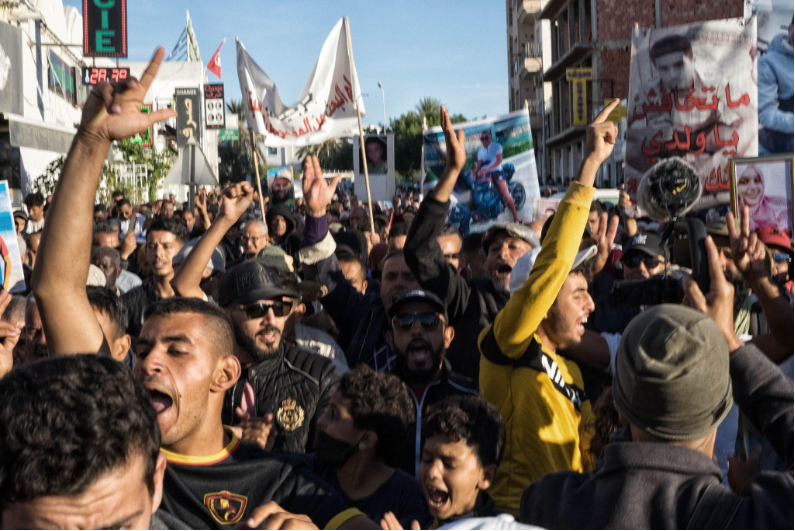 Protest in December 2022 in Zarzis. Source: Felice Rosa
Protest in December 2022 in Zarzis. Source: Felice Rosa
From November 7, the occupation of the square facing the Zarzis delegation was followed by the occupation of the Commercial Port, a free zone and major commercial hub, which lasted for about two weeks. It was from there that on 18 November a protest march took off in the direction of Djerba on the day of the opening of the Francophonie Summit. This was an attempt for the families and inhabitants to take their plight to the attention of their country’s ministers and the international community.
As part of this march, at least 2 kilometers of cars crowded the lanes, fully occupying the road leading to the bridge linking Zarzis with the island of Djerba. Some 4 kilometers before the bridge, however, anti-riot security forces had already blocked the way, waiting to suppress the peaceful demonstration and halt the citizens’ advancement: adults, women, the elderly, and children alike were not spared police batons and tear gas. Many young people, including dozens of minors, and several leaders of the protest movement were captured and detained at the roadblock. As people headed back to the town center, they found that more security forces, tear gas, and violence were awaiting them: the repression of the demonstration and the arrest of especially minors and young men led to an escalation of clashes lasting several nights. On Thursday 23 November, civil society organizations and activists from Tunis traveled to Zarzis in solidarity with the families of the disappeared.
What Zarzis has been witnessing in the past months is not only the result of the rotten functioning of Tunisian institutions at local, regional, and national levels. It is also the ultimate product of the European Union’s border externalization policies, which erect an unquestionable, vertical relationship between the northern and southern countries of the Mediterranean resulting in Tunisia’s coast being guarded at all costs.
 Handmade banner for the October 18 general strike. Source: Felice Rosa
Handmade banner for the October 18 general strike. Source: Felice Rosa
The inhabitants of Zarzis understand this shipwreck to be a state crime, as they have strong suspicions of the direct involvement of the National Maritime Guard or of the Tunisian Navy in having caused the accident at sea on the evening of 21 September, 2022. This state crime was rendered possible by a repressive border control nexus encouraged and financed by the European Union and its member states prioritizing violence and security over human lives.
In the same months as this protest movement has been unfolding, several videos have been shared showing the Tunisian National Maritime Guard deliberately compromising the stability of border crossers’ boats in order to stop them and bring them back to North Africa. Tunisian and transnational civil society organizations released a statement in December 2022 denouncing the violent practices of the Tunisian coast guard and the deliberate sinking of border crossers’ boats off the coast of Tunisia.
In recent years, Tunisia has pursued a security-led migration management approach whose cornerstone relies on border control and, in particular, on reducing the number of departures. The number of interceptions at sea by Tunisian authorities has increased exponentially in recent years. In 2022 alone, at least 25.020 persons were intercepted by Tunisian authorities, compared to just over 3.580 in 2019. These policies, which aim to limit departures from Tunisia of both Tunisians and nationals of other countries (mainly from the African continent), make migration routes more dangerous and at the same time force hundreds of people to live in circuits of irregularity, facing incredible difficulties in accessing rights and services. The living and health conditions of many migrants who arrived or ended up in Tunisia have worsened. They often live in extremely critical conditions and, in the absence of a legal framework guaranteeing their rights, they are increasingly the victims of extrajudicial arrests.
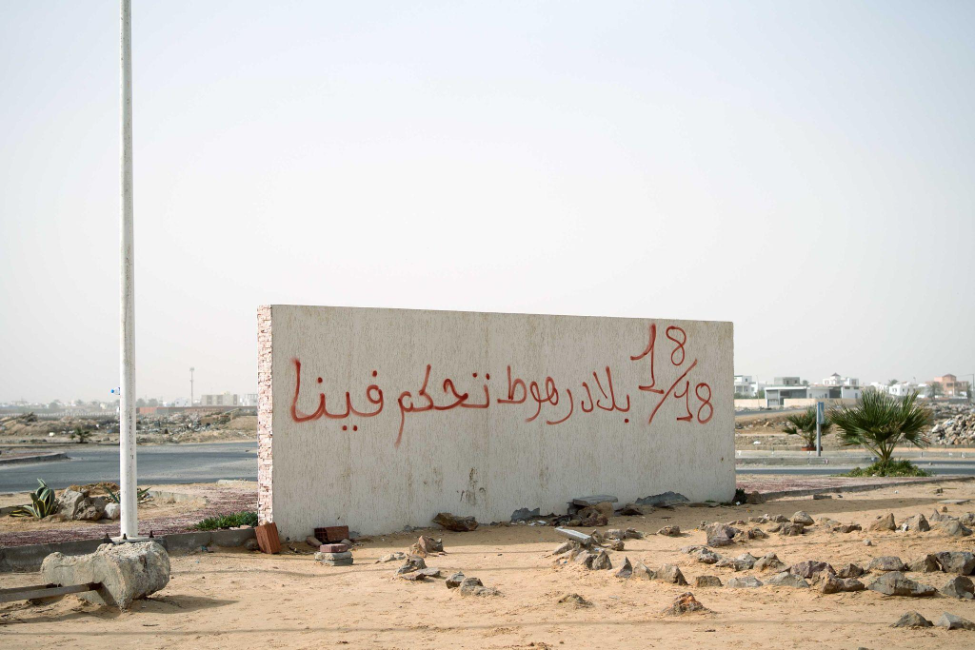 Tag at the occupation of the Commercial Port in Zarzis :“18/18 bad people are ruling us”. Source: Felice Rosa
Tag at the occupation of the Commercial Port in Zarzis :“18/18 bad people are ruling us”. Source: Felice Rosa
Legal discretionality and racist violence are the pillars of the border regime in the Central Mediterranean. In countries on both sides of this liquid border, the impunity of state authorities and the difficulty of investigating their unlawful and deadly operations at sea persist. In Zarzis, another protest march was organized on 6 January 2023, in response to President Kais Saied stating that the authorities were working to dismantle smugglers’ networks in the region. This latest statement confirmed what the families and citizens of Zarzis feared all along, and which continues to fuel their struggle – namely that their state would be unlikely to investigate what truly happened on the night of September 21, 2022, and thus bring the navy or the coast guard to justice.
Much like in Italy, France, and other European countries, it is the border crossers themselves and those helping them who are criminalized, leaving unquestioned the policies that make safe and legal mobility impossible for the vast majority of the world’s population, and allowing the abuses perpetrated by the authorities while guarding borders to continue. These crimes concern the Tunisian Maritime Guard as well as the Libyan coast guard, and go to uphold the now established practice of non-assistance by the Italian authorities, as well as the push-backs involving the Maltese Maritime Guard.
We reiterate our commitment to oppose the discretionary nature of the law and the racist violence of border regimes. We stand in solidarity with the families and with the whole community of Zarzis in their demands for truth and justice.
3 Attacks by the Tunisian Coast Guards
In December 2022, along with other organizations, Alarm Phone publicly denounced the increase in attacks by Tunisian coast guards on migrant boats, in a statement entitled “Deadly policies in the Mediterranean: Stop the shipwrecks caused off the coast of Tunisia”:
“Beating people with sticks, firing shots in the air or in the direction of the engine, knife attacks, dangerous maneuvers to attempt to sink boats, demanding money in exchange for rescue… The practices of the Tunisian coast guard as reported by the migrants who have encountered them are more than alarming. These practices kill, as was the case last month, when a migrant boat was, according to survivors, violently rammed by the Tunisian National Maritime Guard. Following this attack off the Tunisian town of Chebba, reported by various media, three children drowned”
In this analysis, we publish one of the testimonies collected by Alarm Phone from a survivor of one of these attacks, who now arrived in France and wants to make visible what he had suffered during his journey.
Testimony from J., survivor of a coast guard attack:
“My name is J., I am 21 years old and I am from Ivory Coast. I arrived in Tunisia in January 2021 after working for a while in Algeria. I settled in Sfax where I worked with the idea of crossing to Europe. After a year and a half, I managed to save 2200 euros for the crossing.
We left on Monday 29th August at 8 pm from Mahdia with a wooden boat and a 90-horsepower engine. We were 38 people (from Ivory Coast, Guinea and Cameroon), including a woman who was pregnant.
Around 11pm, the Tunisian National Guard spotted our boat and approached us. They were two people (an old man and a young man) on a small blue, white and red boat with the number “112”. They asked the captain to cut the engine. We refused, saying that we did not want to return to Tunisia. Then the coast guard did a u-turn, they took their momentum and went straight to our boat. Fortunately, they did not succeed in capsizing us.
Then they stuck their boat to ours and started hitting the captain with a stick. When they pointed a gun at the captain and threatened to shoot, one of my Ivorian brothers tried to intervene. The coast guard threw a knife at him and it hit him in the head. He was bleeding a lot. The coast guard fired in the air.
Between 11pm and 1am the next day, the coast guard stayed near us and did everything they could to try to sink us. They continued to hit us and started to fill our boat with water using a can cut in half. When they saw that this technique would not work to sink our boat, they started to hit us again and again.
For two hours we fought with them. At about one o’clock in the morning, they tried to capsize our boat by leaning on the edge. To defend ourselves, we threw our water bottles at them. Their engine was damaged and we were able to escape.
Between 1:00 and 6:00 in the morning, we continued on our way. At about 7 km from the international waters, our boat stopped because we ran out of gas. We started to drift. We had no water or food. We came across a boat with Libyans, who had left Libya and were heading for Italy, but they refused to help us. The waves finally pushed us back to the Tunisian coast and we alerted the coast guard.
The Tunisian National Guard came to pick us up on Wednesday at 5pm, almost two days after our departure. They hooked a rope to our boat to tow us but it broke. They then asked a fisherman to tow us himself.
We were disembarked in the port of Chebba. The coast guards laughed at us and insulted us. When we got out of the boat, a woman who was very tired could not get up. We tried to help her, but the national guard told us to leave her and made us sit further away.
A little later, while we were still detained in the port, one of the Cameroonians asked about the woman who had stayed in the boat (also Cameroonian). He was summoned alone to the office of the national guard. The coast guard told him that the woman was dead but that he had to keep it a secret or else he would have problems.
It was on the bus to Sfax that the Cameroonian man shared this sad news with us. We are sure that they let her die like that, without doing anything. We informed the husband of the deceased woman. He came to Tunisia. The coast guard told him that his wife died because she was shipwrecked, but this is not true.
My friend who was injured with the knife went to Tunis. We supported him with money so that he could go to the hospital there for treatment. I am a little injured in the shoulder, because I tried to push back the boat of the National Guard when it was coming towards us. I asked for help from Doctors of the World but they told me that they could not do anything for me because of my financial situation (I told them that I had no money to pay).
This kind of attack happens often. I was with a friend on the boat who recognized the older of the two coast guards. He had already attacked his boat earlier in the month, and it had caused a shipwreck. The problem is that migrants are afraid to speak out because they might be arrested.”
4 The emergency of large boats leaving eastern Libya
Since late 2016, crossing the Mediterranean to Europe from Egypt’s northern coast has decreased sharply. But recently, the migration of Egyptians across Egypt’s long desert border with Libya and from Libya’s Mediterranean coast to Europe is increasing. In 2022, over 20,000 people who arrived by boat along the coast of Italy were of Egyptian nationality, making them the largest national group, followed by Tunisian and Bangladeshi nationals.
In 2021, more than 26,500 Egyptians were stopped at the Libyan border, according to a document issued by the EU Commission last year. The increasing number of Egyptian migrants coming through the Central Mediterranean route has prompted the EU to demand that Egypt abide by the agreements signed in 2015 and 2017 related to combating irregular migration.
 A view from a coast guard observatory center in Rosette. Source Kashefx
A view from a coast guard observatory center in Rosette. Source Kashefx
On 30 October 2022, the EU signed an agreement with Egypt on border security, valued at 80 million Euros, agreeing to provide support Egypt in “search and rescue and border surveillance at land and sea borders.”
According to its 20 point Action Plan, the EU will work to strengthen the capacities of Tunisia, Egypt and Libya to develop joint measures to prevent irregular migration, support more effective management of land and sea borders, and strengthen search and rescue capabilities.
Boats departing from the east of Libya became more common since the summer of 2022, with many Egyptians, Bangladeshis and Syrians embarking on overcrowded boats. This is also due to the fact that Syrians and Bangladeshis are able to access Libya fairly easily, especially via Benghazi airport. In order to avoid the dangers of the conflict-torn Libya, including arrests, kidnappings, or exposure to violence, some of those who arrive in east Libya try to depart quickly on boats.
The route from east Libya has also become more desirable recently as there is no intensive control such as that imposed on the western coasts of the country under the authority of the Tripoli government, due to the agreements signed between Libya’s interim government and a number of EU member states. Very large boats have left from Tobruk – fishermen call them ‘sea bulldozers’ – carrying 400 to 700 people on board.
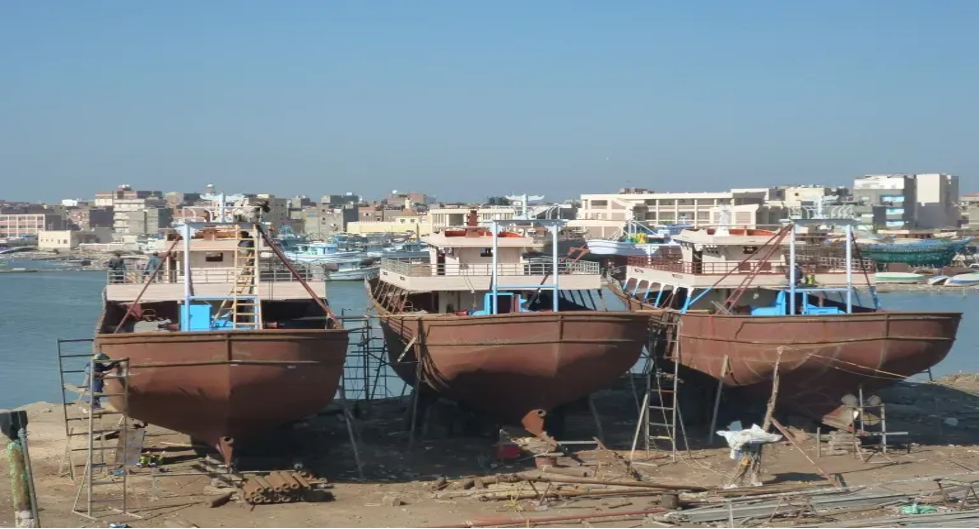 Ship workshop in Borg city of Burullus, October 2022. Source: Maysarathustra
Ship workshop in Borg city of Burullus, October 2022. Source: Maysarathustra
Some sources attribute the departures of large boats in part to the release of prominent members of Egyptian smuggling networks who had been imprisoned due to several disastrous shipwrecks in 2015 and 2016 that had left hundreds of people dead off the Egyptian coast.
5 “Their voices are getting weaker”: EU authorities deny basic care
On 12 September 2022, the Italian Coastguard brought 26 people to Pozzallo. The rescued people reported that they had been at sea for several days after departing from eastern Libya. Two people were evacuated to Malta for medical treatment: A girl in a serious state of dehydration and her mother. The survivors reported that also six people had died during the journey: Two children, aged one and two, a 12-year-old and three adults. As UNHCR reported after assisting the landing, that the victims had died of hunger and thirst.
In 2022, we had to experience many times that Maltese authorities failed to recognize boats that were still moving as distress cases, thereby endangering all those on dangerously overcrowded boats. We also had to experience how RCC Malta failed to recognise people on the move as human beings as such, ignoring their basic needs and their right to life.

The photograph of a sick Black person who was carried down the stairs off the merchant vessel Talia in the year of 2020 comes to mind, symbolising the denial of basic care. The vessel had rescued a group of 52 people in distress adrift in a rubber boat, as state actors did not send rescue. Only after many days of international protests and in cooperation with the crew and captain of the Talia, the rescued people were finally allowed to disembark in Italy, after a long standoff near the coast of Malta. The Maltese authorities had been fully aware of the dire medical condition of the rescued, but decided to deny the Talia to land.
Only a few months before, we had already experienced how people on the move were slowly dying while the Maltese and Italian authorities were fully aware of the situation. A rubber boat was adrift in Maltese waters for days and eventually people were violently forced by to Libya. Twelve people died due to dehydration and hunger, some throwing them into the sea out of desperation. A recently leaked OLAF report confirmed that Frontex aerial asset had been present at the scene, fully aware of the disaster unfolding below.

These forms of suffering on boats in distress – thirst, dehydration, hunger, exhaustion, injuries – are regularly ignored by EU authorities. When people call us in distress from the sea, we often have to tell them that while we are trying our best to mobilise rescue, it can take many hours or even days until rescue will arrive – if rescue arrives at all.

On the phone we often can hear the total exhaustion in people’s voices. Many times they report that they had no water or food left for days already. Sometimes, they start to drink sea water, which worsens their health further. In our alerts to authorities, we do not only inform them about the GPS positions of the boats but also about the condition of the people. We tell them that there is no water or food left, that some are injuried or sick. However, this does not seem to get the Italian or Maltese authorities to end their systematic forms of non-assistance. People fleeing from Libya often have to be able to reach the Italian SAR zone – a few nautical miles off the coast of Italy, otherwise they are regularly ignored.
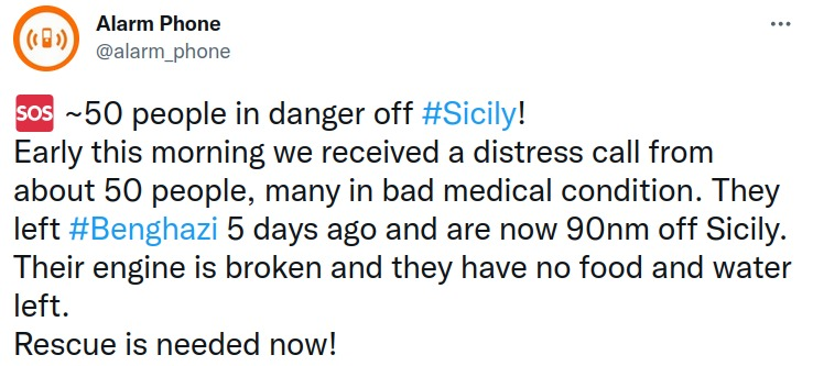
In the afternoon of 26 October, Alarm Phone was called from 35 people in the Maltese SAR zone. As usual, authorities failed to react to our alerts. We stayed in contact during the night. In the morning of 26 October, the person on the phone had told us: “the engine is working, but we stopped because of exhaustion”. In the afternoon, the NGO-vessel Ocean Viking found the boat and rescued them.
Actors of the civil fleet report frequently about the critical physical conditions of people after rescues. As The sailing boat Nadir tweeted in July 2022”: The crew discovered another overcrowded boat in distress yesterday in the Maltese SAR zone. There were 85 people on board, some dehydrated and exhausted from their arduous flight, including a pregnant woman.”
We see these acts of European non-assistance as acts of torture – consciously prolonging the pain and suffering of people on the move as a form of punishment for ‘daring’ to move without authorisation.
6 Merchant vessels – are they of any use to rescue boats in distress?
Already in the first half of 2022, but even more so during the last six months, the Alarm Phone started receiving more and more calls from boats which had left from the east of Libya or even Lebanon or Turkey, heading towards Sicily or the Italian mainland. The so-called Libyan Coast Guard somewhat adapted to the new route and started to intercept some of those boats, including exceptionally big ones carrying more than 500 people. But by the time they call the Alarm Phone, most of the people have already reached the Maltese SAR zone and sometimes are approaching the SAR zone shared between Malta and Italy.
In our experience and to our frustration, RCC Malta usually does not react to distress cases in their area of responsibility and claims to “monitor” the situation instead of intervening, a practice that costs lives. Also the civil fleet, because of long distances and limited resources, is up to now not very active in the area southeast of Sicily. So quite often the only chance for us to help the people in distress is trying to alert nearby merchant vessels and put pressure on coast guards to coordinate rescue operations. For Alarm Phone, reaching a merchant vessel via their company or insurance is not an easy task, especially at night or on weekends.
As the responsible Rescue Coordination Center, RCC Malta could easily direct a merchant vessel to a known distress case, however, from the times we were able to establish direct contact with a merchant vessel we were sometimes told that RCC Malta had given explicit orders to the merchant vessel not to assist the boat in distress (!) which could be argued to be a violation of international maritime law. It even happened that a merchant vessel in the Maltese SAR zone was ordered by RCC Malta to bring people back to countries of departure, south of the Mediterranean Sea, thus carrying out an illegal pushback. Experiences with the Italian Coast Guard, especially in Sicily, are better: During the last months, MRCC Rome even coordinated a few rescue operations outside their own Italian SAR zone.
The following text gives some examples about our experiences with merchant vessels – first the bad ones and then some good examples.
Push backs supported by merchant vessels
On 23 July, the Vos Triton, a Gibraltar flagged offshore tug/supply ship of the Vroon Offshore Services LTD, rescued about 100 people in international waters off Libya. Instead of taking them to a safe country, they transshipped all people to a patrol boat of the so-called Libyan Coast Guard and they were forced back to detention in Libya. The same happened already about one year earlier, when the Vos Triton handed over 170 people to the so-called Libyan Coast Guard.
On 23-26 September, a boat carrying 23 people who had alerted Alarm Phone was close to several merchant vessels in the Maltese SAR zone. For hours, the merchant vessels were waiting for RCC Malta to finally initiate a rescue. But Malta refused and told us that they will only bring over fuel. We lost contact with the people on the boat and could only observe on online maps that most of the merchant vessels left the scene. But the Shimanami Queen, coming from Egypt and heading towards Europe, changed course, approached the last known position of the boat and then turned around and headed towards Egypt. Together with MSF, Sea Watch and contacts in Egypt we could finally find out that RCC Malta instructed the Shimanami Queen to take the 23 people to Egypt, from where most of them had fled. On 19 October, we published a detailed report on this case.
 Track of the vessel Shimanami Queen. Source: @sea-watch.org
Track of the vessel Shimanami Queen. Source: @sea-watch.org
RCC Malta instructed merchant vessels not to assist or rescue
On 05 September, Alarm Phone was alerted by a boat from Lebanon, carrying about 60 people. They had reached Maltese SAR and needed urgent assistance. We alerted authorities, but eleven hours later, no help had arrived. A merchant vessel informed us that RCC Malta said they would not support them in case they assisted the people in distress. The Maltese authorities continued to stay silent. Nonetheless, after being informed by relatives, we believe that the boat was rescued by a merchant vessel to Malta.
On 17 December, RCC Malta instructed two merchant ships to ignore the case of a boat with 45 people in distress in Maltese SAR and even threatened consequences. The Sea Eye 4 could finally reach the boat in time and take all people on board.
Merchant vessels assisted boats until the coast guard finally rescued
On 28 July, about 45 people who had fled from Egypt, alerted Alarm Phone from a boat south of Crete. The people told us that they had been at sea for four days already. On 30 July, the group was found by the merchant vessel Sea Galaxy in Maltese SAR. We were told that they would be brought to Malta in the morning. But three days later, the people called us in panic, saying that their engine was on fire. The M/V Sea Galaxy had left the scene. The Greek Coast Guard who was also responsible, as the boat had reached the Greek SAR border, told us that so far they did not recognize the boat as a distress case. Finally we managed to convince them that the merchant vessel Heranger should change course to the boat. Then we lost contact with the people. Only on 02 August, we heard from the Greek Coast Guard that nearby vessels reported to them that rescue had been conducted by AFM Malta. This was confirmed by Maltese media – RCC Malta continued to stay silent.
On 21 October 2022, Alarm Phone was alerted by about 32 people who had fled from Benghazi, eastern Libya, who were running low on fuel in international waters. Later we were told that three merchant vessels in the area were searching for the boat. We lost contact to the group in the Maltese SAR zone, but reportedly, RCC Malta had instructed the tanker P.FOS to follow this boat while it was still moving north. After days of following their dangerous journey, the 32 people have safely reached Pozzallo, finally rescued by Italy.
 Position of the tanker P.Fos on Vesselfinder near the boat in distress. Source: Alarm Phone
Position of the tanker P.Fos on Vesselfinder near the boat in distress. Source: Alarm Phone
On 11 November, about 27 people adrift in international waters called Alarm Phone. They had fled from Benghazi, Libya, and had problems with their engine. We alerted authorities, but no rescue came. We got in contact with the company of the merchant vessel Castor, which diverted its course to assist the people in distress. In the meantime, the people on the boat had managed to fix the engine a bit and reached Maltese SAR on an erratic course. But it took a long time until a Maltese patrol boat arrived and delivered life vests to the people in distress. RCC Malta then told the Castor to keep at least four nautic miles distance for rescue operations and later even to leave the area. In order to ensure their safety, the M/V Castor stayed near the boat until all people were on board the Maltese patrol boat. Finally on 13 November, UNHCR confirmed that 28 people had disembarked in Malta.
Merchant vessels rescued
On 31 July, a Maltese freighter rescued 113 people in distress, about 140 nautical miles from Benghazi and 240 nautical miles from Sicily, and took them off the coast of Portopalo, where they were transshipped to the port with a shuttle of an Italian patrol boat.
On 10 September, a boat from Turkey was rescued by the merchant vessel Arizona. The boat had left already on 30 August. The rescue operation was coordinated by MRCC Rome in Libyan SAR. Later, the Italian Coast Guard took over the people and brought them to Pozzallo, Sicily. Three children and three women had died of dehydration on the boat, as it was unnoticed for a long time.
On 30 September, 33 people who had alerted Alarm Phone were rescued by the merchant vessel Maersk Athabasca. We had accompanied them directly on the phone for days. Seabird 2 had sighted the boat and sent four Mayday alerts but Malta, despite being the responsible rescue coordination center, did not act and instead ignored the people in distress, leaving them with bad weather for a whole night. Seabird 2 could also inform merchant ships and document the rescue.
 Position of the boat in distress on 30 September. Source: Alarm Phone
Position of the boat in distress on 30 September. Source: Alarm Phone
On 26 October, MRCC Rome coordinated a rescue of 150 people by the merchant vessel Christina. The boat in distress was still in the Libyan SAR zone. They were brought to Trapani, Sicily.
On 04 November, two boats which had alerted Alarm Phone were rescued by the merchant vessel Zagara in international waters off Libya. The 34 survivors and two dead bodies on one of the boats were brought to Italy. On the same day, the Zagara rescued a second boat carrying about 27 people in the same region and brought them to safety. The operation was coordinated by MRCC Rome outside their SAR zone.
Merchant vessels used in coast guard rescue operations
During the last months, many boats, especially big fishing vessels coming from the east of Libya, Lebanon or Turkey, were rescued in operations coordinated by the Italian Coast Guard. They did not only include assets of the Guardia di Financia and of Frontex, but often MRCC Rome also instructed merchant vessels to rescue some of the sometimes more than 500 people on those boats. This is one example of such a rescue operation:
On 05 December, about 450 people alerted Alarm Phone, coming from Tobruk, and we tried to contact merchant vessels, as RCC Malta did not react, but at some point lost contact to the people in distress. We were relieved when they were finally rescued by the Italian Coast Guard and at least two merchant vessels, the tankers Humble Warrior and Chemical Voyager, also the Neptune Thelesis was ordered for protective shading.
7 Chronology of SAR Events, July – December 2022
JULY
In July, Alarm Phone was alerted to 69 boats in distress in the Central Mediterranean, 56 of them departing from Libya, 12 from Tunisia, one from Egypt. 16 of these boats were rescued by NGO vessels. Via several sources, we know of 85 other boats which left from Libya and of 157 boats which departed from Tunisia. Most of the boats from Tunisia arrived autonomously in Lampedusa or were rescued near the island by the Italian Coast Guard. Some were intercepted and brought back to Tunisia. Two boats from Tobruk (east Libya) were rescued by the Italian Coast Guard to Sicily. Only one boat, carrying about 40 people, arrived in Malta. There were at least 22 interceptions by the so-called Libyan Coast Guard or by the other Libyan actor, Stability Support Apparatus (SSA). We know of five shipwrecks off Libya, leading to at least 66 deaths and 86 people going missing.
On 1 July, a charter flight from Libya, with nearly 100 refugees on board landed in Italy, bringing them to safety, following a “humanitarian corridor“ agreement between churches, state and UNHCR. Such safe ways should be open to all – nobody should be forced to leave on unseaworthy boats.
On the same day, at least 22 migrants died off Libya after 9 days at sea according to some 60 survivors brought back to shore by the Libyan Coast Guard.
On 2 July, a boat carrying about 140 people was rescued by the Italian Coast Guard to Sicily. It had left from Tobruk, east Libya.
On 3 July, the Ocean Viking rescued 63 people who had alerted Alarm Phone from an overloaded wooden boat in the Maltese SAR area. It was the 7th rescue in less than 10 days.
On 4 July, a boat carrying Libyan and Syrian nationals, capsized off Sabratha coast. Two children and a man died while local fishermen managed to rescue the others.
On 7 July, 41 people were rescued by the Geo Barents from two fibre boats in distress in the Maltese SAR Zone after an alert by Alarm Phone.
On the same day, Libyan Coast Security received a German delegation of the Federal Police. . They discussed about support against “illegal immigration and human smuggling“.
On 9 July, the scientific service of the German Bundestag confirmed that the ban on flights over the Libyan search and rescue zone, affecting for example Sea-Watch’s Seabird, is not legitimate.
On 10 July, Sea-Watch reported that over 2,000 people had arrived on Lampedusa in July. The hotspot on the island was overcrowded. The navy transported 600 people to Sicily, shortly after another group of 600 people.
On 17 July, Alarm Phone was alerted by six people clinging to a buoy near Kerkennah island. However, the Tunisian Coast Guard was not able to find them and the people were not reachable any more. Alarm Phone asked the authorities to continue the search.
On 18 July, the prime minister of the Libyan Government of National Unity, Abdul Hamid Dbeibeh, created an unexpected alliance with his former enemy, the warlord Khalifa Haftar, in a bid to cement a fragile ceasefire and end a months-long oil blockade. On the same day, media sources reported that the EU and Niger had signed a new agreement against human traffickers“.
On 19 July, Alarm Phone reported that over the last weekend, dozens of boats had arrived autonomously on Lampedusa. Many others were rescued by the Italian authorities and the Rise Above. Several of the boats had alerted Alarm Phone.
On 20 July, Libyan units of Western Region Support Forces raided a smuggler‘s safe house in Al-Jamil area and apprehended 81 people awaiting transport for boat crossing to Europe.
On 21 July, Alarm Phone was in contact with a large group of people on a rubber boat in the Maltese SAR. After being ignored by RCC Malta for many hours, the group in distress was finally rescued by Italy, as Malta again refused to take responsibility. We thanked the crew of the merchant vessel VICTORIA who had supported the group for many hours.
 Map showing the position of the boat on 21 July in Maltese SAR. Source: Alarm Phone
Map showing the position of the boat on 21 July in Maltese SAR. Source: Alarm Phone
On 22 July, the Libyan Marine Detachment of Rahba al-Duru Bn commenced regular patrols off the coast of Qarabolli “for purpose of combating human smuggling and illicit activities of foreign entities in Libyan waters“.
On 23 July, Alarm Phone was alerted by a boat in distress with 113 people on board, who were fleeing from Sabratha. Fortunately, the Sea-Watch 3 found and rescued them.
On 24 July, a large disembarkation took place in Sicily: A fishing boat adrift with more than 600 people was rescued the day before, about 124 miles off Calabria, by a merchant ship, three Coast Guard patrol boats and a Guardia di Finanza unit. Five lifeless bodies were also found on board the vessel. A total of 674 people were rescued. In total, nearly 1,200 arrived in Italy by boat in 24 hours.
On 25 July, Alarm Phone reported about a busy weekend: We had been alerted to six boats with over 500 people, rescued by the Civil Fleet (Sea-Watch 3 and Ocean Viking).
On the same day, about 100 people were illegally pulled back to Libya by the Vos Triton vessel and about 150 people were intercepted by the SSA Marine Detachment in two separate operations off the cost of Sabratha
On 26 July, the Geo Barents rescued six boats, three of them had alerted Alarm Phone.
On the same day, another evacuation flight from Libya to Italy took place. Major clashes in Tripoli left 16 people dead. The UN Security Council discussed the latest developments in Libya.
On 27 July, SSA Marine Detachment patrols interdicted in 7 different operations more than 745 migrants. All were disembarked in Al Maya and brought to the SSA detention center.
On 29 July, a patrol of the Tunisian Coast Guard intercepted 63 migrants off the coast of Mahdia. The people had lost their way after being abandoned by a Libyan smuggler who jumped off the boat and returned to Libya with help of accomplices.
On the same day, we were called by ~40 people in severe distress who fled from east of Libya. The so-called Libyan Coast Guard told us they would go to intercept the boat. On 01 August, we heard from relatives that the people had arrived in Italy.!
On 30 July, a group of migrants, who had alerted Alarm Phone from the Maltese SAR zone, was found by the merchant vessel Sea Galaxy. Malta ignored our demands to clarify if they were acting. One day later the boat entered the Greek SAR zone, but Greece did not recognize the boat as a distress case. Only on 3 August, after abandoning them for days at sea, the Armed Forces of Malta carried out an operation, disembarking the 45 people.
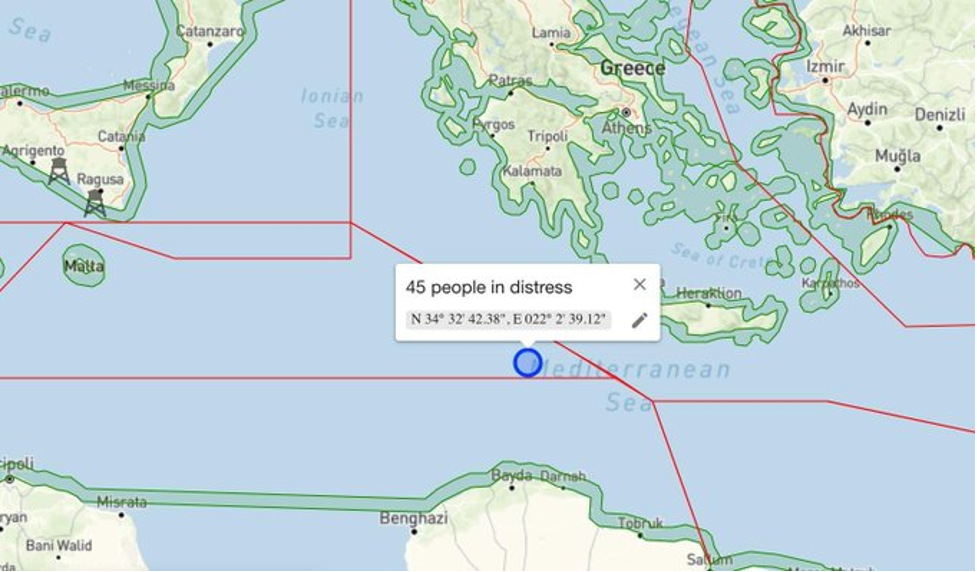 Map showing the position of the boat on 1 August. Source: Alarm Phone
Map showing the position of the boat on 1 August. Source: Alarm Phone
On the same day, the sailing ship Nadir responded to a distress call from Alarm Phone and found an overcrowded boat with 120 people on board. Eventually, they were rescued to Lampedusa.
On 31 July, a Maltese merchant ship rescued 113 migrants and took them to the coast of Pozzallo where they were trans-shipped to the port on a patrol boat.
End of July, MSF and ECRE reported about the last two weeks in the Central Med:
1,500+ people rescued & assisted by NGO vessels
1,200+ people rescued by coast guards off and coasts
55+ dinghies arrived autonomously in Italian coasts
Violence, abuse & interceptions by authorities
According to IOM, in the period of 24 – 30 July 2022, 977 migrants were disembarked back on Libyan shores.
AUGUST
In August, we were alerted by 71 boats in distress, among them 50 from Libya, 15 from Tunisia, three from Lebanon and three from Turkey. 13 of these boats were rescued by NGO vessels. From diverse sources, we know about 43 other boats which left from Libya and around 170 boats from Tunisia. There were days in the first half of this month when up to 18 boats, carrying more than 400 people, arrived in Lampedusa in a single day. Only 84 people (two boats) arrived in Malta. We know of at least 23 boats which were intercepted by the so-called Libyan Coast Guard or by the SSA and also more than before by the Tunisian Coast Guard. We learned about seven shipwrecks, four off Tunisia, two off Libya and one off Algeria, which lead to at least 28 deaths and 74 people going missing.
On 01 August, the European Court of Justice (ECJ) ruled in the case of Sea-Watch 3 and 4, confirming that rescue at sea is a duty and port state controls must not be used arbitrarily against NGOs in the future to detain ships and prevent them from doing their work. This means concretely: Italy can’t demand an imaginary certification that doesn’t even exist under the German flag. Also, the number of rescued persons isn’t a reason for the ship’s detention.
On 03 August, three NGOs of the Civil Fleet, SOS Mediterranée, MSF and Sea Watch, wrote in a statement that within the last two weeks, they had rescued about 1,500 people on 21 boats in distress. 13 of these boats had alerted Alarm Phone and we could relay their GPS positions to authorities and the NGO rescuers.
On 04 August, the 659 survivors on the Geo Barents could disembark in Taranto, after nearly nine days at sea.
On 06 August, Alarm Phone was alerted by about 35 people in distress in Maltese SAR. Malta announced to send the so-called Libyan Coast Guard. After losing contact to the boat for 24 hours, the ~35 people in distress called us again. They were in the SAR zone shared by Italy and Malta. On 09 August, we learned that they were rescued by the Italian Coast Guard to Augusta.
On 09 August, we learned about a shipwreck off Algeria: While six people survived with injuries, six people drowned off the Algerian coast. Several people went missing.
On the same day, three children and three women died in a shipwreck off Kraten, Kerkennah in Tunisia. At least four people went missing. On 10 August, we learned that the death toll of this shipwreck had risen to eight, four children and three women.
On 11 August, the Astral could prevent another disaster. The Seabird2 spotted the drifting boat already the day before in the Maltese SAR zone and alerted the authorities – but in vain. Alarm Phone had also alerted authorities to this group. If no civil rescue ship had been on site, these people would have drowned. The rescue took place in high winds and rough seas 13 nautical miles south of the Sicilian island of Lampedusa.
On 12 August, we learned about a shipwreck off Libya. SSA Marine Detachment patrol boat found survivors of a sunken boat off the coast of Zuwara. According to testimonies of survivors, there were 36 people on the boat. While 18 people survived, at least 18 people went missing. The survivors were mostly imprisoned, we were told.
On 13 August, media sources reported that the Tunisian Coast Guard had intercepted 184 migrants on 12 August and thwarted 12 “illegal sea crossing“ operations.
On 14 August, we received the information that the 18 people in distress, who had alerted Alarm Phone already on 12 August and reported that two people fell overboard, arrived in Pozzalo. European authorities kept ignoring all calls for help and refused to provide assistance.
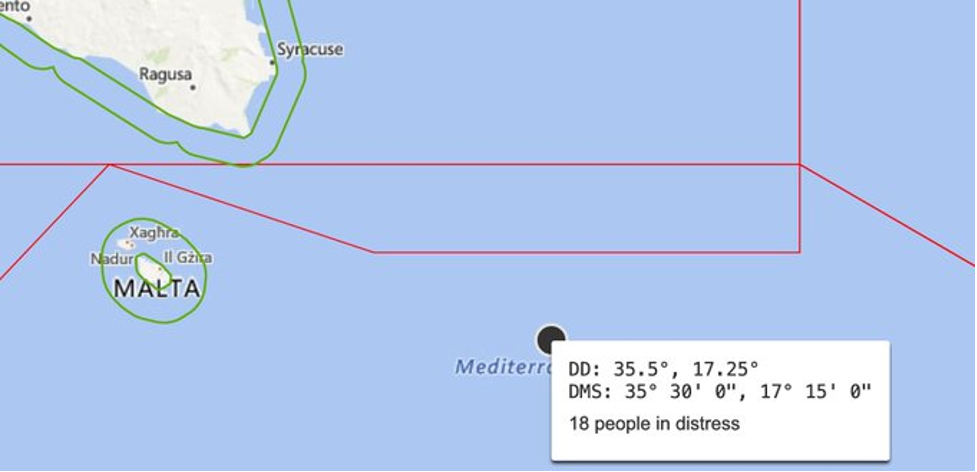 Map showing the position of the boat in Maltese SAR on 12 August. Source: Alarm Phone
Map showing the position of the boat in Maltese SAR on 12 August. Source: Alarm Phone
On 15 August, 10 people on a tiny boat from the east of Libya, who had alerted Alarm Phone, were assisted by the merchant vessel Bull with water and food before continuing its route. The boat was finally rescued to Pozzallo in Sicily.
On 16 August, several units of the Italian Coast Guard and the Gurdia di Finanza (GDF) committed to the rescue of a fishing boat off the coast of eastern Sicily, Calabria with about 500 people on board.
On 17 August, 101 people called Alarm Phone when in serious distress at sea. They had escaped from Libya. We alerted authorities as well as Open Arms who rescued the group with its new rescue asset.
On the same day, Sea-Watch reported about a boat in distress in the Maltese SAR zone: Malta refused to rescue, the so-called Libyan Coast Guard intercepted the people.
On 18 August, the SSA thwarted at night off the coast of Sabratha the departure and seized a boat of about 45 migrants. All were transferred to the Al-Maya detention center.
On the same day, Alarm Phone was alerted by a group of 44 people, many of whom were sick. They had fled from Libya and were drifting close to Malta. Two days later, relatives informed us that the people were rescued and disembarked in Malta.
On 21 August, we learned that 1,000+ people who arrived in the last 24 hours between Roccella (Calabria), Augusta and Portopalo (Sicily) had departed from Turkey and Libya.
On the same day, the Geo Barents team received an alert by the Italian Maritime Rescue Coordination Centre to a boat in distress in the Italian SAR zone. 106 people were rescued and disembarked in Taranto.
On 22 August, we learned about another shipwreck off Tunisia: Three bodies were recovered on a beach near the Libyan border.
On 23 August, 645 people were rescued by the Italian Coast Guard and the GdF in the Ionian Sea and brought to different ports in Sicily.
On 25 August, the Astral located a boat with 112 people on board, who had also called Alarm Phone, and performed a joint rescue operation with the Ocean Viking.
On the same day, a SSA Marine Detachment patrol boat interdicted off the coast of Zuwara a wooden boat with about 130 migrants on board.
On 26 August, 26 people called Alarm Phone when in distress at sea. Not EU authorities but the sailing ship Nadir came to rescue. Alarm Phone was alerted to two further boats in distress, carrying 40 and 119 people respectively. This time it was the Ocean Viking and the Astral that came to the rescue.
On the same day, a boat, carrying 80 people, was in immediate danger near the Libyan coast. In our last phone call the people could see a fast boat arriving. We hope the delayed intervention of the so-called Libyan Coast Guard, who complained to us about lacking resources while they routinely intercept boats near the Maltese SAR boundary, hasn’t cost lives at sea in this case.
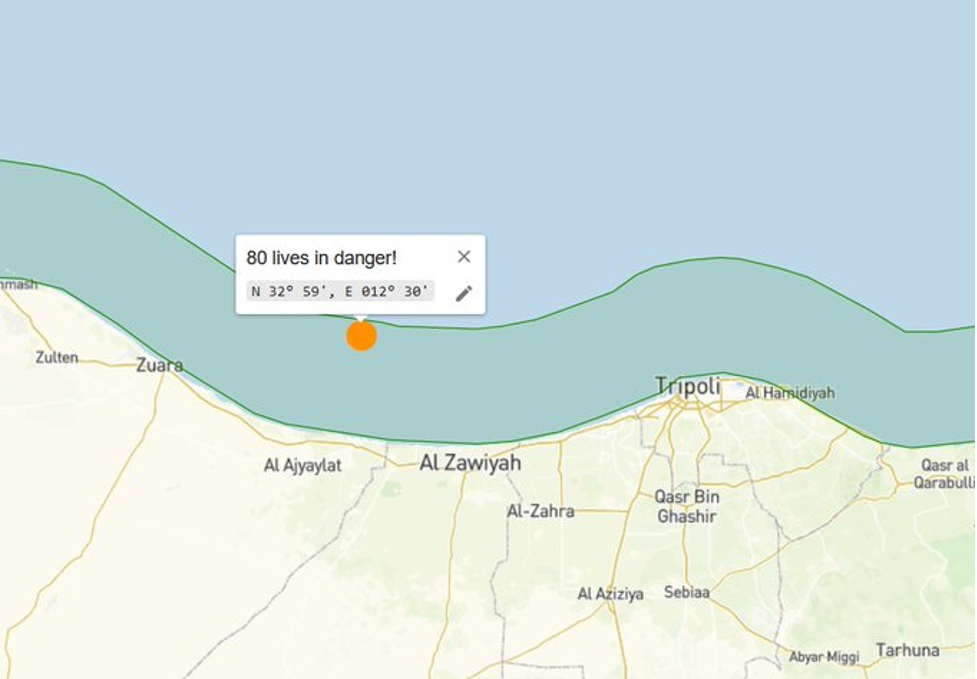 Map showing the position of the boat in distress on 26 August. Source: Alarm Phone
Map showing the position of the boat in distress on 26 August. Source: Alarm Phone
On 26/27 August, the so-called Libyan Coast Guard intercepted in different operations a total of 520 migrants. All disembarked in Zawiya.
On 27 August, clashes broke out in Tripoli between different militias, causing the loss of many lives. Refugees detained in Ain Zara were terrified, fearing for their lives during these clashes.
On the same day, a boat carrying 27 migrants capsized at night off Talmitha/Libya. One migrant managed to swim back to shore, six persons were rescued and two bodies recovered.
On 28 August, 25 people escaping from conflict-torn Libya alerted Alarm Phone when in distress at sea. We informed authorities as well al the Geo Barents, whose crew carried out a successful rescue. They rescued another boat that had alerted Alarm Phone. This was their fourth rescue in less than 48 hours.
On 29 August, 84 people on seven boats from Tunisia arrived at the Italian island of Pantelleria and were later transferred to Trapani.
On the same day, we learned that about 1,000 migrants reached southern Italy over the weekend.
On 30 August, Malta refused again a rescue in its SAR zone. A Maltese military vessel ignored a Mayday call. Instead, the so-called Libyan Coast Guard came. Malta even instructed a merchant ship that had already changed course to help the boat in distress NOT to do so.
On 31 August, Alarm Phone was contacted by a boat in distress that had left from Lebanon to Italy with about 57 people. The axe of their boat had broken and they were drifting. The NordicHamburg merchant ship Bruce received orders from RCC Malta to assist the 80 people in distress with water and food. After waiting for 2-3 hours they were ordered to leave and continued their route leaving the people behind. Only on 2 September, relatives informed us that the people in distress had reached Malta. We do not have any news from the Maltese authorities but hope that this is true and that they have safely reached Europe.
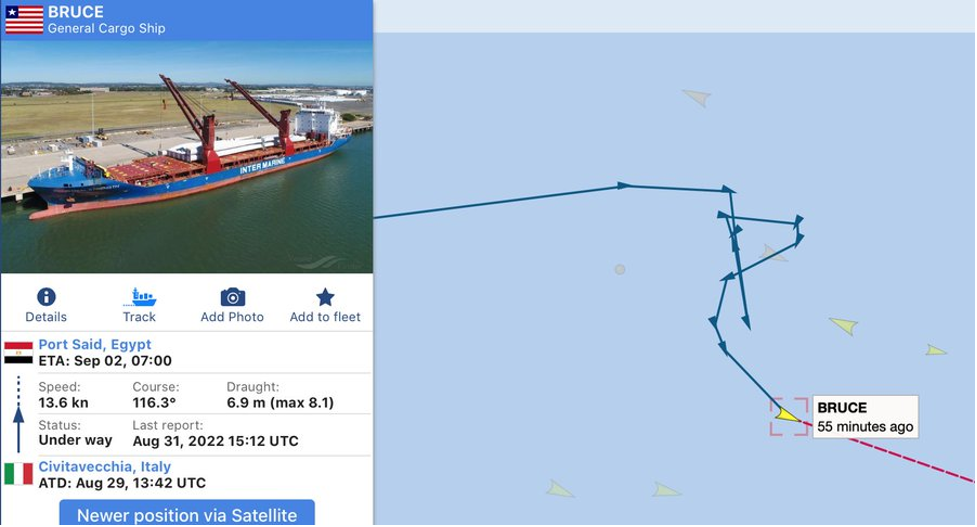 Track of the merchant vessel Bruce near the boat in distress, shown on 31 August on Vesselfinder. Source: Alarm Phone
Track of the merchant vessel Bruce near the boat in distress, shown on 31 August on Vesselfinder. Source: Alarm Phone
On the same day, a group of about 70 people called Alarm Phone. They reported they had injuries from the latest violent clashes in Libya. Authorities ignored their call for rescue for eight hours. Eventually, this group was intercepted by the so-called Libyan Coast Guard and brought back to inhuman conditions in Libya.
SEPTEMBER
In September, Alarm Phone received distress calls from 87 boats, 47 of them left from Libya, 31 from Tunisia, six from Lebanon, one from Egypt (of two boats we do not know where they left from). 15 of these boats were rescued by NGO vessels. From different sources, we know about the departure of 26 other boats from Libya, 74 from Tunisia, one from Lebanon. Most of them arrived in Italy. Only two boats arrived in Malta, carrying about 140 people. We were informed about 17 interceptions to Libya. We know of five shipwrecks off Tunisia and four off Libya. In total, 42 people were reported dead, 74 missing.
On 01 September, a boat was intercepted by the SSA and the 123 people on board transferred to SSA detention Center Al-Maya. Another 80 migrants were rescued from a dilapidated rubber boat by the Libyan navy. Off Sardinia, five bodies of men who had drowned while trying to migrate to Europe were recovered.
On 03 September, families of the disappeared, activists and civil society groups came together for CommemorAction events in Zarzis, Tunisia. Ten years earlier, on 6/9/2012, a boat with 130 people from Sfax had capsized near Italy – only 56 people were rescued. Families still search for the missing.
 Pictures of missing people at a CommemorAction event in Zarzis, Tunisia. Source: Alarm Phone
Pictures of missing people at a CommemorAction event in Zarzis, Tunisia. Source: Alarm Phone
On 05 September, Alarm Phone published a list of boats departing from Lebanon that reached out to us over recent days:
These cases included a group of approximately 50-65 people who contacted Alarm Phone on 30 August and were eventually pushed back to Turkey by the Hellenic Coastguard.
A group of about 80 people (first wrongly reported as 57), who Alarm Phone was alerted to on 31 August – long period of non-assistance, eventually rescued to Malta.
A group of approximately 80 people who Alarm Phone was alerted to on 3 September that finally managed to reach Roccella in Italy.
A group of approximately 60 people who contacted us on 2 September and seems to have been rescued by a merchant vessel to Malta.
On the same day, a counter-trafficking workshop took place in Tunis with the Libyan Ministry of Social Affairs and a group of twenty Libyan Government representatives.
On 06 September, a demonstration together with families of the disappeared from many countries took place in Zarzis, protesting the violence of the European borders. UNCHR official Vincent Cochetel reacted to this demonstration with a tweet, blaming the mothers of missing refugees. In the following days, this tweet by Cochetel drew in a lot of criticism from activists, human rights organisations, families of disappeared and others, even the UNHCR itself. Cochetel apologised. But together with many groups and family members, we called on UNHCR to dismiss their special envy or for Mr Cochetel to resign.
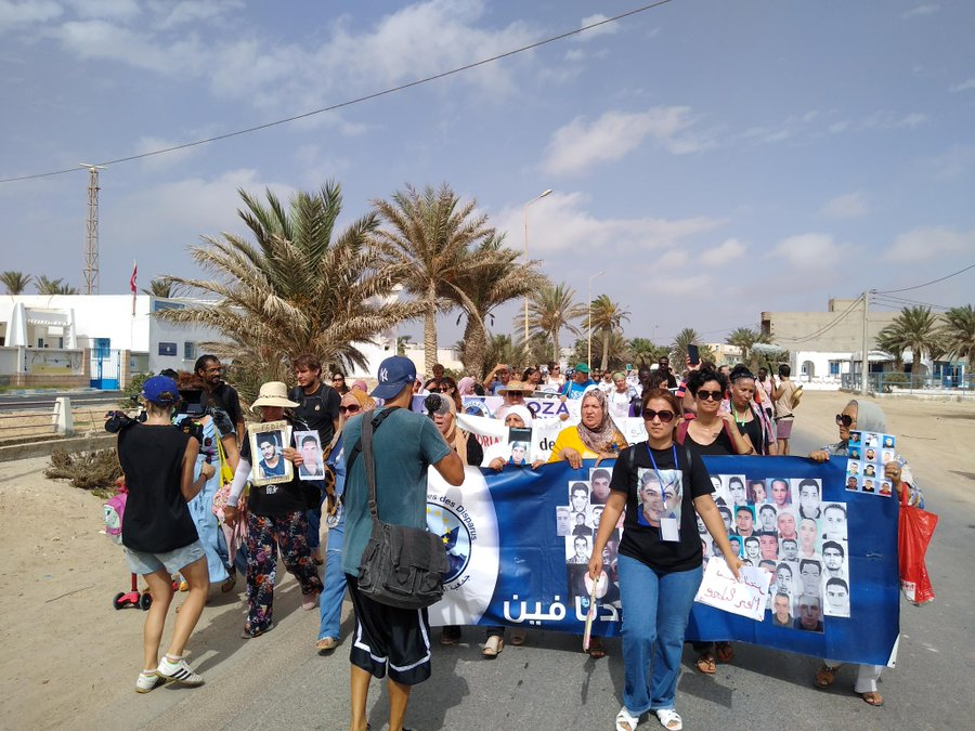 Demonstration together with families of the disapeared in Zarzis, Tunisia, on 6 September. Source: Alarm Phone
Demonstration together with families of the disapeared in Zarzis, Tunisia, on 6 September. Source: Alarm Phone
On 07 September, media sources reported that Malta would receive €52.3 million in European funds to deal with migration.
On the same day, not AFM, but an Egyptian cargo vessel rescued stranded Lebanese migrants who had alerted Alarm Phone near Malta. A four-year old girl died when a boat with about 60 people on board was eventually rescued by the merchant vessel BBC PEARL, after many days of non-assistance by Malta and Greece.
On 08 September, the border regime again caused several lives when a boat capsized the day before off Chebba, Tunisia. Only fourteen people were rescued, eight bodies were found.
On 09 September and the days before, hundreds of people were rescued by the civil fleet. But also almost 2,400 people were forcibly returned to Libya. Many of them had alerted Alarm Phone, like a boat in distress off the coast of Khoms. Also, several shipwrecks off Tunisia were reported. Tunisian Coast Guards prevented 26 migration attempts, intercepted 426 people and seized twelve boats.
On 09/10 September, SSA intercepted in separate operations five boats and arrested a total of 380 people.
On 11 September, two boats that had alerted Alarm Phone were rescued by the Sea-Watch 3.
On 12 September, media sources reported that a critically ill child and mother were evacuated to Malta. Their boat had been rescued by a Liberian-flagged merchant ship off the eastern coast of Libya. The ship, which was sailing near the distressed boat, rescued all people and took them on board after it was instructed to do so by Italy’s Coast Guard.
On 13 September, a shipwreck happened off Al-Khums/Libya. The so-called Libyan Coast Guard found 50 people alive and recovered one dead body. At least nine people went missing.
On 14 September, we learned that a boat carrying 207 people who had alerted us two days before in Maltese SAR zone, was finally rescued by the Humanity 1. They found many dehydrated people, but fortunately no death on board could be confirmed.
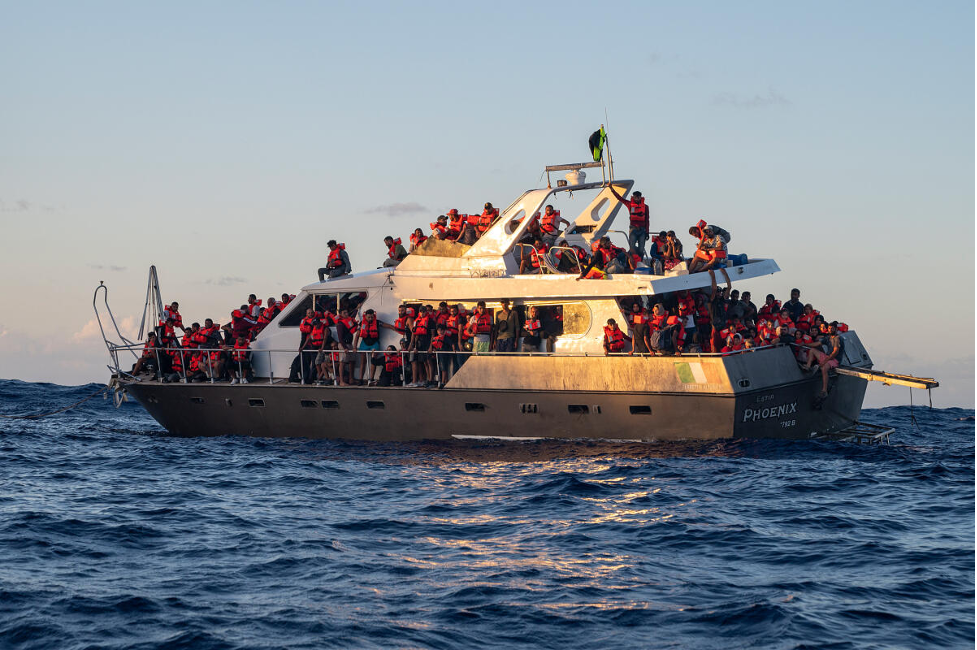 Boat carrying 207 people rescued by the Humanity 1 on 14 September. Source: Arez Ghaderi / SOS Humanity
Boat carrying 207 people rescued by the Humanity 1 on 14 September. Source: Arez Ghaderi / SOS Humanity
On 15 September, the Italian Coast Guard rescued about 380 people from a fishing boat off Calabria.
On the same day, the European Commission confirmed that €23 million would be allocated still in 2022 and €57 million in 2023 to provide equipment and services to Egyptian authorities for “search and rescue and border surveillance at land and sea borders”.
On 16 September, the Sea-Watch 3 declared state of necessity after ten requests for a port of safety. Finally, the Italian authorities assigned them a port in Reggio di Calabria.
On 17 September, the Open Arms rescued 59 people, who had alerted Alarm Phone, from Miskar oil platform after searching more than 24 hours for the boat. They also found a corpse on board.
On 18 September, a group of 294 people who Alarm Phone was in contact with was spotted by Colibri 2 and finally rescued by the Open Arms Uno.
On 19 September, the Open Arms Uno rescued another 30 people on a very precarious boat that had reached out to Alarm Phone.
On 20 September, media sources quoted Maltese Minister of Home Affairs: “The cooperation of Malta and Libya prevents immigrants’ boats from reaching Europe“.
On 21 September, the Geo Barents conducted a difficult rescue following an alert by Alarm Phone in the international waters near Libya. 76 people were on board of an overcrowded rubber boat in distress.
On 22 September, the sailing ship Nadir supported 75 people on two boats. One of them had alerted Alarm Phone. After many hours, an Italian Coast Guard ship finally arrived. In risky manoeuvres, it picked up all the people from the Nadir.
On 23 September, a boat with over 150 people on board capsized after departing from Lebanon. Only 20 survivors were found. 34 bodies were retrieved. More than 100 people are missing. Two days later, the death toll had risen to 94.
On the same day, a shipwreck occurred off Sfax. Seven people were rescued, about twenty went missing. Worried relatives contacted Alarm Phone, but we had never been in contact with this boat.
On 24 September, Alarm Phone was alerted about a missing boat with about 17-18 people onboard, who had left from Zarzis on 21 September. For weeks we were in touch with more than 30 relatives, friends, community members, and only on 06 October, we were informed about a shipwreck off Tunisia. The body of a woman who had left Zarzis 15 days earlier as part of a group of 18 people was found and identified.
On 25 September, fighting broke out between rival militias in Zawya/Libya. At least five people died and 13 were injured.
On 26 September, Malta instructed merchant ship SHIMANAMI QUEEN to take 23 people to Egypt, from where they had fled, rather than to closer ports in Europe. Alarm Phone was alerted by the people in distress on 23 September, lost contact and could only observe that several merchant vessels were near the boat’s last known position but later left the scene. Together with Sea-Watch and MSF, we could get confirmation from JRCC Cairo that the SHIMANAMI QUEEN, which was on the way from Egypt to Europe, had got order to rescue the people in Maltese SAR and disembark them in Egypt.
On 27 September, a big boat with 369 people on board was rescued to Sicily by several assets of the Italian Coast Guard and a Spanish Frontex vessel according to ANSA (Italian press agency).
On 29 September, a boat carrying 88 people alerted Alarm Phone to their distress situation. We informed relevant authorities as well as the MV Louise Michel. It was again the civil fleet, not EU actors, who responded and carried out a successful rescue operation.
On the same day, 400 people on a big boat were rescued to Calabria in an operation coordinated by the Italian Coast Guard.
On 30 September, 33 people who had alerted Alarm Phone were rescued by the merchant vessel MAERSK ATHABASCA. We had accompanied them on the phone for days.
OCTOBER
October was a very busy month for Alarm Phone and the Civil Fleet. We were alerted by 112 boats, 52 of them coming from Libya, 51 from Tunisia, two from Turkey, one from the Ionian Sea (of six cases, the place of departure was unclear). 17 of these boats were rescued by NGO vessels. We know of 16 other boats which departed from Libya and an unknown number from Tunisia. Most of the boats arrived in Italy (Lampedusa, the boats from Turkey and from the Ionian Sea in Sicily or Calabria). Only two boats arrived in Malta. We know of 28 boats which were intercepted by the so-called Libyan Coast Guard. Some were brought back to Tunisia. We learned about two shipwrecks off Libya, leading to at least 18 deaths and nine people going missing.
On 01 October, Alarm Phone reported that, over the past days, we had been alerted to several boats in distress that had left from Tunisia. A boat with 41 people on board was intercepted to Sousse. The survivors told us that three people had died during the journey. A boat close to Sicily, carrying about 71 people who alerted us was rescued by the Italian Coast Guard.
On 04 October, the Louise Michel found 48 people in distress who escaped Libya and who had called Alarm Phone during the night. EU coastguards failed to respond to our calls for rescue.
On 07 October, 17 refugees were burnt to death by unidentified individuals in the city of Sabratah inside a boat. The incident took place at night during the loading of the boat. The survivors were attacked by one of the smugglers who after stealing engines and fuel supplies set the boat on fire.
On 08 October, around 250 people arrived in Pantelleria on 15 different boats, all rescued by the Italian Coast Guard.
On the same day, the Louise Michel assisted 29 people on a boat in distress. The people reported
that in Libya, they were forced at gun point to swim out from the shore to a wooden boat. While being beaten with guns, two minors, aged 14 and 16, drowned.
On 09 October, protests in Zarzis/Tunisia returned again against the silence of the Tunisian authorities and the lack of interaction with citizens who ask for information about the boat that went missing on 21.09.2022 with 18 people on board.
On 10 October, Alarm Phone was not able to reconnect with two boats in distress, one carrying 200, the other one 100 people. Libyan authorities failed to inform us whether these people had been among the hundreds of people who were intercepted and forcibly returned to Libya. A third boat that alerted us had a shipwreck. We were informed by the so-called Libyan coastguard that the majority of the about 100 people on this boat survived. Sadly, they also reported that several people went missing.
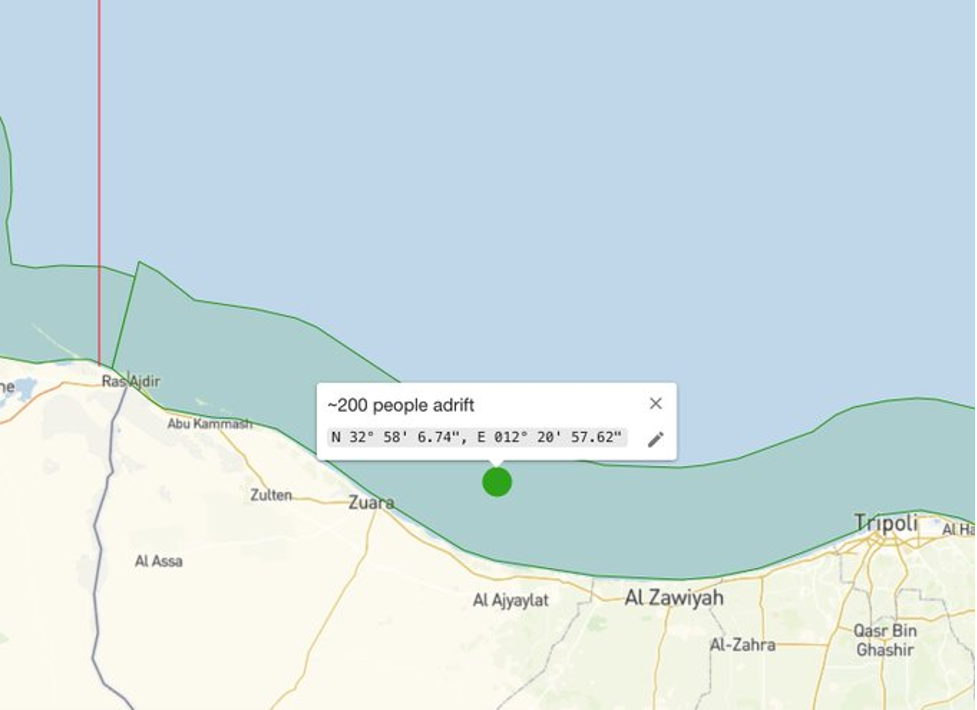 Map showing the position of the boat carrying 200 people in distress. Source: Alarm Phone
Map showing the position of the boat carrying 200 people in distress. Source: Alarm Phone
On the same day, a pullback of about 50 people from the Maltese SAR to Libya was observed by the Seabird crew.
On 11 October, a shipwreck occurred south of Sicily. Three bodies were recovered by the Italian Coast Guard.
On 12 October, 37 people who had alerted us the day before from the Italian SAR zone, were found and rescued to Italy. Nine people on a small fiberglass boat in distress were rescued by the Geo Barents, following an alert by Alarm Phone.
On the same day, we learned that in two separate shipwrecks off Tunisia, at least 20 people had died over the past few days.
On 13 October, the Geo Barents rescued another boat that had alerted Alarm Phone. 122 people, including more than 90 minors, had been in distress on an overcrowded rubber boat.
On 14 October, several bodies were recovered on the coast of Zarzis, Mahdia and near Bizerte, Tunisia. DNA analyses of four bodies exhumed at the foreigners’ cemetery in Zarzis upon request of the families revealed that three of them belonged to the group where 18 people went missing when the boat sunk near Zarzis. In the night, clashes broke out in several Tunisian cities. People chased the governor of Medenine of Zarzis.
On 15 October, Alarm Phone joined the International Action Day ‘Stop Italy-Libya Memorandum’. Since 2016 over 100.000 people, many of whom called us when in distress, have been forcibly returned to Libya through EU-Libyan collaborations.
On 17 October, the Geo Barents rescued two more boats with 40 and 76 people on board, who had alerted Alarm Phone. During the night, the Nadir found a fishing boat that had previously rescued 35 people from an inflatable boat. The survivors had been on the water for three days. Shortly after the Nadir arrived, Tunisian customs approached the fishing boat. In cooperation with the fisherman, the Nadir crew managed to inform the Italian authorities in time and prevented the Tunisian authorities from returning the survivors to Tunisia. Finally, the Italian Coast Guard took the people on board.
On 18 October, a general strike took place in Zarzis/Tunisia. Protestors requested authorities to continue the search for 12 people who went missing at sea. For weeks, families were trying to understand what happened after the missing departed on 21.09.2022. Fishermen have been leading the search for the missing. While the Tunisian Coast Guard failed in their duty to rescue people in distress and to search for the missing, the Governor of Medenine let recovered bodies be buried without an identification process. Protesters were calling for a more intensive search for the many people still missing.
 General strike in Zarzis, Tunisia, on 18 October. Source: Alarm Phone
General strike in Zarzis, Tunisia, on 18 October. Source: Alarm Phone
On 19 October, it was reported that Abd al-Rahman Milad, known by his alias Bija, one of the world’s most wanted human traffickers, head of an infamous Libyan militia, and Commander of the so-called Libyan Coast Guard was recently honored by the Libyan government.
On 21 October, there was an explosion on a boat travelling through Malta SAR, close to Italy’s SAR zone. Two children died, several persons went missing. It might be that it was a boat we alerted authorities about to the day before.
On the same days, several boats were intercepted: 37 boats from Tunisia. one from Sabratha, West Libya. Daily shore patrols between Qarabolli and Zliten, east of Tripoli, took place.
On 22 October, 34 people in distress who had called Alarm Phone when escaping from Libya were found and rescued by the Ocean Viking.
On 23 October, we learned that 32 people, who had alerted Alarm Phone two days before off Benghazi, safely reached Pozzallo in Italy. The group had fled from Libya but ran out of fuel and was drifting in international waters. We lost contact to the group in Malta SAR zone. Reportedly, RCC Malta had instructed the tanker P.FOS to follow this boat while it was still moving north. We thanked the merchant vessel crews that offered their support.
On 24 October, two shipwrecks occurred off Lampedusa. Three children and several others went missing.
On the same day, Alarm Phone was alerted by a large boat in distress off Sicily, carrying about 400 people. They were already four days at sea. Fortunately, a rescue operation was carried out by the Italian Coast Guard.
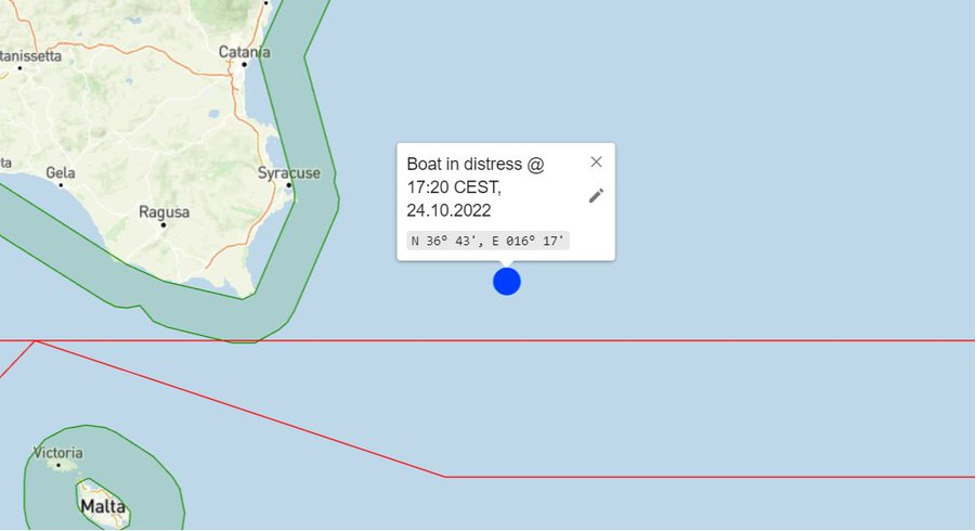 Map showing the position of the boat in distress, carrying about 400 people. Source: Alarm Phone
Map showing the position of the boat in distress, carrying about 400 people. Source: Alarm Phone
On 25 October, we were alerted by a large wooden boat that had left Tobruk, Libya, and was in the SAR zones of Malta and Italy. We were told that the ca. 700 people had left together with about 650 people on a second boat. Finally, about 1,300 people were rescued in an operation coordinated by the Italian Coast Guard.
On 26 October, the Ocean Viking rescued two boats which had alerted Alarm Phone. Another boat we were in contact with was intercepted by the so-called Libyan Coast Guard, as well as several other boats.
On 27 October, it took a long time until the so-called Libyan Coast Guard reacted to our distress call for a group who had fled from Khoms, Libya, and reported their boat was sinking. The people were returned to Libya. Several other boats were rescued by the Civil Fleet.
On 28 October, Alarm Phone was called by a large vessel in distress, carrying over 300 people. The weather was very dangerous in the Mediterranean and the people on board feared for their lives. One day later, their boat was drifting less than 40 miles from Crete and close to capsizing, according to the people on board. Nevertheless, the boat continued and some days later, reached Italian SAR zone. According to the Italian Coast Guard, on 03 November, there was a rescue operation to bring the people to safety. Finally, they were brought to Crotone, Calabria.
On 29 October, we learned that three days before, Italy had coordinated a rescue by a merchant vessel outside their own SAR zone. The boat, carrying about 150 people, had alerted Alarm Phone.
On 30 October, we received a distress call from about 50 people, many in bad medical condition. They had left Benghazi five days earlier and were 90nm off Sicily. While MRCC Rome refused to share any info with us, merchant vessels who observed the rescue reported that the ca. 50 people were taken on board an Italian coast guard vessel and probably disembarked in Sicily.
NOVEMBER
In November, we were alerted by 42 boats, 12 of them had departed from Libya (five of them large boats from Benghazi, one from Tobruk), 23 from Tunisia, one from Lebanon, one from Algeria (of five boats we do not know from where they left). None of these boats were rescued by NGO vessels. Most of them arrived in Lampedusa. Those from Eastern Libya were rescued by merchant vessels and/or the Italian Coast Guard. Only two boats (113 people) arrived in Malta. We know of nine other departures from Libya and more than 20 from Tunisia. At least ten boats were intercepted by the so-called Libyan Coast Guard. We know about 18 deaths and nine people going missing in four shipwrecks off Tunisia, but there were more shipwrecks of which we have no data.
On 01 November, a large boat at risk of capsizing alerted Alarm Phone off Sicily. Authorities were informed and a total of 383 people were rescued to Italy by several assets.
On 02 November, the SSA Marine Detachment intercepted two boats off Libya. On the next day, 107 people were intercepted. All people were brought to the detention center in Al-Maya.
On 03 November, a large boat, carrying over 350 people, was intercepted off Qarabolli, Libya.
On 04 November, 34 people who had alerted Alarm Phone were rescued by the merchant vessel Zagara with Italy as destination. Also two dead bodies were taken on board. The same vessel rescued also about 27 people who had called us in distress in international waters off East Libya.
On 05 November, over 1,000 people on board of four assets of the Civil Fleet were stranded at sea for up to 15 days, blocked by the Italian government.
On 06 November, Italian authorities asked the Geo Barents to enter the port of Catania to assess cases of vulnerability. 357 were disembarked, 215 were instructed to stay on board. Also the Humanity1 was only allowed to disembark a selection of the rescued and then asked to leave the port with 35 survivors on board. SOS Humanity, later also MSF, took legal actions against this illegal form of collective refoulement. Refugees protested and three of them plunged into the sea from the Geo Barents. More than two hundred doctors denounced Italy’s “behaviour contrary to professional ethics” by the Maritime Health Service. Protests took place at the responsible Ministry in Rome and in other cities. UNHCR and IOM published an appeal for urgent disembarkation of all stranded people.
 Protest in front of the responsible ministry in Rome on 6 November. Source: @Cantiere and @RescueMed
Protest in front of the responsible ministry in Rome on 6 November. Source: @Cantiere and @RescueMed
On 07 November, a large rescue operation, coordinated by the Italian Coast Guard, was carried out off the east coast of Sicily. A boat carrying about 500 people had alerted Alarm Phone in distress the day before. The people were brought to Augusta and Pozzallo.
From 20 October to 07 November, NGO ships (Geo Barents, Ocean Viking and Humanity1 rescued about 1,000 people. In the same period, nearly 11,000 people landed in Italy.
On 08 November, the 89 people on the Rise Above could disembark in Reggio Calabria. The 35 survivors remaining on board the Humanity1 announced that the majority of them had been on hunger strike for about two days. After the refusal of the captain of the Geo Barents to leave the port and another assessment of vulnerability done by the Italian health authorities, all 213 survivors on the Geo Barents were allowed to disembark.
On 09 November, also the 35 people rescued by the Humanity1 were finally able to disembark. The Open Arms had decided to head towards France. But instead of Marseille, the military port of Toulon was assigned and the people kept in the “waiting area” to be distributed to other EU countries or to be deported. Fortunately, most of them could finally enter France, but two were deported to Mali.
On the same day, a boat carrying 16 people that had left the day before from Bizerte, Tunisia, sank just two kilometer off the coast. Ten people were rescued or swam to safety, four were missing and two bodies have been found.
On 10 November, the Nadir crew assisted the rescues of five boats in distress with a total of over 200 people. One boat capsized during a rescue operation of the Italian Coast Guard, but all 37 people could be rescued.
On 11 November, 295 people were intercepted off Libya and a Tunisian patrol boat chased a boat of people and caused the death of three children.
On 12 November, a boat carrying about 27 people, who had alerted Alarm Phone, was assisted by the merchant vessel Castor. It stayed near the boat until Malta finally sent a rescue ship. On the next day, we were happy to confirm that the 28 people had disembarked in Malta.
On 13 November, Alarm Phone was in contact with three boats in distress in Malta SAR zone. We hope that at least two of them were rescued in a large operation off Sicily.
On 14 November, about a thousand people were rescued to Sicily and Puglia by the Italian Coast Guard.
On the same day, another boat, carrying 16 people, sank off Tunisia. Four people were reported dead, two missing.
On 16 November, the SSA arrested two Libyan flagged fishing vessels which had left from Zuwara and the so-called Libyan Coast Guard rescued 43 people, who had called Alarm Phone, from a drifting boat.
On 18 November, people from Zarzis were marching towards Djerba, as it hosted the OI Francophonie summit. They protested against neglect by government officials.
On 19 November, 36 people adrift in Maltese SAR were finally rescued to Malta.
On 20 November, another massive operation of the Italian Coast Guard was launched to rescue about 500 people on a large boat off Syracuse, Sicily.
On 21 November, the EU Commission unveiled a so-called action plan to tackle irregular arrivals via Central Mediterranean.
On 23 November, a vigil was held in Tunis in support of the families of the 18 Tunisian people who lost their life trying to cross the Mediterranean in September.
On 24 November, a new station of the so-called Libyan Coast Guard was opened in Qarabolli.
On 25 November, an extraordinary council meeting of the EU interior ministers on sea rescue took place. Again, new rules for civil rescue ships were discussed.
On 28 November, it was announced that OLAF, EU’s anti-fraud watchdog, had opened an investigation into the European Union’s Asylum Agency (EUAA) based in Malta, following serious allegations regarding mismanagement and fraudulent conduct.
On 29 November, a boat that left from Tobruk, carrying about 500 people, was forcibly intercepted and seized by Libyan Special Naval Forces.
On 30 November, 114 people were evacuated on a UNHCR charter flight from Libya to Italy.
DECEMBER
In December, Alarm Phone was alerted to 67 boats, 30 of them from Libya, 37 from Tunisia. From different sources, we heard of 15 more boats from Libya, several of them large boats from Tobruk or Benghazi in the east, and at least 49 boats from Tunisia. Eight boats were rescued by NGO vessels. Most of the boats from Tunisia arrived autonomously in Lampedusa or were rescued by the Italian Coast Guard, some were intercepted. We know of 21 interceptions to Libya. At least five shipwrecks happened. We heard of at least eleven people who died and 17 going missing.
On 01 December, a boat carrying about 250 people off eastern Sicily was rescued by the Italian Coast Guard.
On 02 December, a boat from Sfax capsized west of Lampedusa. 40 people were rescued. The three who were reportedly missing may have been trapped in the hull of the capsized boat.
On 04 December, a boat capsized off Janzour, Libya. All people managed to swim back to shore, where they were arrested by the security forces.
On 05 December, a boat from Benghazi with 39 people in distress, who had alerted Alarm Phone the day before, was probably among two boats to Pozzallo, Sicily, rescued by the Italian Coast Guard
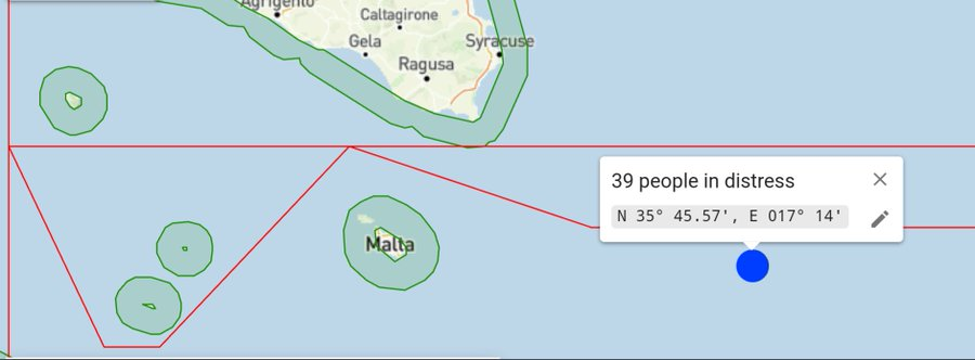 Map showing the position of the boat in distress in Maltese SAR. Source: Alarm Phone
Map showing the position of the boat in distress in Maltese SAR. Source: Alarm Phone
On the same day, the Geo Barents rescued a boat with 90 people on board who had alerted Alarm Phone. A boat with 78 people on board, also an Alarm Phone case, crashed on the rocks of Guiticia at Lampedusa and capsized. According to ANSA, the people were injured, but managed to save themselves by climbing on the rocks.
On 06 December, 450 people who had left on a big fishing boat from Tobruk and 32 people adrift off Sicily, who had both alerted Alarm Phone, were rescued by the Italian Coast Guard to Sicily.
On the same day, the crews of the Louise Michel and the Humanity1 witnessed an extremely dangerous interception of an overcrowded rubber boat by the so-called Libyan Coast Guard. Six people who went overboard were rescued on board the Humanity1. The others were forcibly brought back to Libya.
On 07 December, Libyan Special Naval Forces intercepted a large fishing vessel off the coast of Tobruk with ca. 570 people on board. The vessel was escorted to Tobruk Naval Base for disembarkation and the people detained.
On 08 December, the judge of Trapani, Sicily, decided that the Italian state would have to refurbish the Iuventa, the humanitarian ship under seizure for five years. It has been plundered, largely demolished and is currently unseaworthy and in danger of sinking.
09 December, a sit-in and a press conference in front of the UNHCR headquarters in Geneva were organised by refugee activists and other solidarity activists .
On 10 December, a demonstration took place in Geneva to criticize the ways in which the UNHCR acts in Libya.
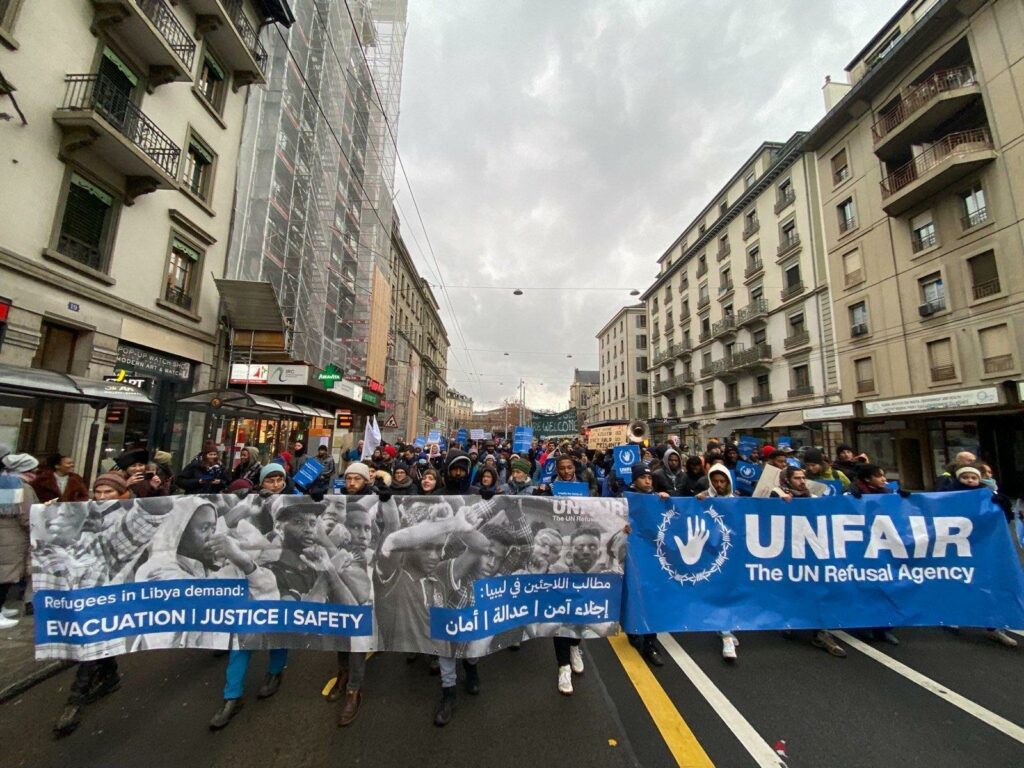 Demonstration in Geneva on 10 December. Source: Alarm Phone
Demonstration in Geneva on 10 December. Source: Alarm Phone
On 11 December, in very bad weather, the Geo Barents and the Humanity1 were assigned ports to disembark far north in Italy (Salerno and Bari) – a new strategy of the Italian government to keep them away from the central Mediterranean.
On 12 December, Judith Sunderland (Human Rights Watch) and Lorenzo Pezzani (Border Forensics) published a new report, also based on Alarm Phone information: “Airborne Complicity – Frontex Aerial Surveillance Enables Abuse”.
On 13 December, 450 people were rescued to Sicily in a large operation coordinated by the Italian Coast Guard, including merchant vessels.
On 15 December, Tunisian authorities told us that at least four people died when their boat sank near Sfax. Authorities claim that 26 of the 30 people on board were rescued.
On the same day, another big boat, carrying 350 people, was intercepted off Tobruk.
On 16 December, the Rise Above rescued a boat with 63 people who had alerted Alarm Phone and was assigned a port in Gioa Tauro.
On 18 December, a boat sank south of Lampedusa. A little girl, among the survivors who arrived on the island, died in the clinic.
On 19 December, the Sea Eye 4 rescued 45 people, and 72 people who had alerted Alarm Phone were rescued by the new vessel Life Support of the NGO Emergency.
On the same day, media outlets reported about a new decree concerning rescues by NGO vessels. According to the decree, rescuers are obliged to enquire into the intention of the rescued whether they want to apply for international protection or not. The ship’s flag country would then be in charge of them after disembarkation. Furthermore, in the event of an intervention in the SAR area, the rescuers would have to immediately ask for a port of disembarkation, towards which the ship will be required to head immediately after the rescue.
Also on 19 December, Alarm Phone published a joint statement “Deadly policies in the Mediterranean: Stop the shipwrecks caused off the coast of Tunisia”.
On 21 December, several boats arrived or were rescued by the Italian Coast Guard to Sicily. Two more NGO ships were assigned ports far north (Livorno).
On 25 December, a shipwreck was reported off Kerkennah islands. The bodies of five people were washed ashore.
On 26 December, 113 people who had alerted Alarm Phone were finally rescued by the Ocean Viking.
On 27 December, another big fishing boat from east Libya, carrying almost 500 people, was rescued to Sicily. It might have been a boat Alarm Phone was alerted to by a relative two days before.
On 28 December, according to the so-called Libyan Coast Guard, about 45 people who had alerted Alarm Phone from a deflating boat, were intercepted by the merchant vessel Anwaar Libya.
 Map showing the position of the boat intercepted by the Anwaar Libya. Source: Alarm Phone
Map showing the position of the boat intercepted by the Anwaar Libya. Source: Alarm Phone
On 29 December, Alarm Phone was alerted by a large boat in distress off Sicily, carrying about 500 people. They said that they were adrift and at sea for three days already. Later they reported that they were next to two large merchant vessels. According to the journalist Scandura, a large rescue operation for the approximately 500 people in distress was carried out.
On the same day, the Italian government published the new decree, attacking sea rescue NGOs. According to Sea-Watch, it is a call to let people drown.
On 30 December, another big boat was intercepted and seized off the coast of Benghazi, carrying more than 650 people.
On the same day, about 45 people who had alerted Alarm Phone, were rescued by the Italian Coast Guard to Sicily.
On 31 December, several boats landed in Lampedusa.